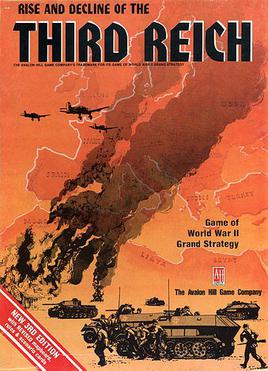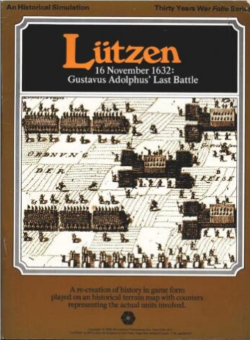
A wargame is a strategy game in which two or more players command opposing armed forces in a simulation of some military operation. Wargaming may be played for recreation, to train military officers in the art of strategic thinking, or to study the nature of potential conflicts. Many wargames re-create specific historic battles, and can cover either whole wars, or any campaigns, battles, or lower-level engagements within them. Many simulate land combat, but there are wargames for naval and air combat, as well.

Miniature wargaming is a form of wargaming in which military units are represented by miniature physical models on a model battlefield. The use of physical models to represent military units is in contrast to other tabletop wargames that use abstract pieces such as counters or blocks, or computer wargames which use virtual models. The primary benefit of using models is aesthetics, though in certain wargames the size and shape of the models can have practical consequences on how the match plays out.
Close Combat is the name of a series of real-time computer wargames by Atomic Games. In the Close Combat series, the player takes control of a small unit of troops and leads them in battles of World War II from a top down 2D perspective.
In tabletop games and video games, game mechanics are the rules or ludemes that govern and guide the player's actions, as well as the game's response to them. A rule is an instruction on how to play, a ludeme is an element of play like the L-shaped move of the knight in chess. A game's mechanics thus effectively specify how the game will work for the people who play it.

Full Thrust is a science fiction strategy wargame written by Jon Tuffley and published by Ground Zero Games of England. It is usually played with miniature figurines representing imaginary starships, although cardboard chits representing the vessels can also be used. Unlike many games, the publishers encourage the use of any miniatures rather than only "official" ones, though Ground Zero Games does also sell an extensive miniature range.
World in Flames is a board wargame designed by Harry Rowland and released in 1985 by the Australian Design Group. It is currently in its 8th edition, World in Flames - Collector's Edition, each new edition featuring changes to the rules, maps and counters provided with the game.

The Russian Campaign is a strategic board wargame published by Jedko Games in 1974 that simulates combat on the Eastern Front during World War II. Avalon Hill later bought the game and produced several editions.

Rise and Decline of the Third Reich or more commonly Third Reich is a grand strategy wargame covering the European theater of World War II, designed by John Prados and released in 1974 by Avalon Hill. Players take on the roles of major powers—Germany, Italy, United Kingdom, France, the Soviet Union, and the United States—from 1939 to 1946.

Grunt, subtitled "The Game of Tactical Level Combat in Vietnam", is a tactical level board wargame published by Simulations Publications, Inc. (SPI) in 1971, set in the Vietnam War. It was the first board wargame to focus on squad level combat, and the second to simulate parts of the Vietnam War, which was still ongoing at the time this game was published.

A block wargame is a board wargame that represents military units using wooden blocks instead of cardboard counters or metal/plastic miniatures.

Kriegsspiel is a genre of wargaming developed by the Prussian Army in the 19th century to teach battlefield tactics to officers. The word Kriegsspiel literally means "wargame" in German, but in the context of the English language it refers specifically to the wargames developed by the Prussian army in the 19th century. Kriegsspiel was the first wargaming system to have been adopted by a military organization as a serious tool for training and research. It is characterized by high realism, an emphasis on the experience of decision-making rather than on competition, and the use of an umpire to keep the rules flexible and manage hidden information. After Prussia's impressive victory over France in the Franco-Prussian War, other countries began designing similar wargames for their own armies.
De Bellis Multitudinis (DBM) is a ruleset for table-top miniatures wargames for the period 3000 BC to 1485 AD. It is the big battle development of De Bellis Antiquitatis. As its name implies, it is aimed primarily at simulating large battles. The rules allow armies to be chosen from published Army Lists using a points system to select roughly equal armies if required.

A set of rules for World War II and the immediate post-war years, for scales from 1:300 micro armour to 1:72 scale, published by Wargames Research Group (WRG).
This glossary of board games explains commonly used terms in board games, in alphabetical order. For a list of board games, see List of board games; for terms specific to chess, see Glossary of chess; for terms specific to chess problems, see Glossary of chess problems.

Corps Commander, or "Corps Commander: Operational Manoeuvre Group" is a set of micro-armour Miniature wargaming rules designed by Bruce Rea Taylor and Andy Ashton and published in the UK by Tabletop games copyrighted by B. A. Rea Taylor, A. Ashton & Tabletop Games July 1986.

A wargame, generally, is a type of strategy game which realistically simulates warfare. A professional wargame, specifically, is a wargame that is used by military organizations to train officers in tactical and strategic decision-making, to test new tactics and strategies, or to predict trends in future conflicts. This is in contrast to recreational wargames, which are designed for fun and competition.

A wargame is a strategy game that realistically simulates warfare. Wargames were invented for the purpose of training military officers, but they eventually caught on in civilian circles, played recreationally.

Agincourt, subtitled "The Triumph of Archery over Armor, 25 October 1415", is a board wargame published by Simulations Publications, Inc. (SPI) in 1978 that simulates the Battle of Agincourt.

The Battle of Borodino: Napoleon in Russia 1812 is a board wargame published by Simulations Publications Inc. (SPI) in 1972 that is a simulation of the Battle of Borodino during the French invasion of Russia in 1812.

Lützen is a board wargame published by Simulations Publications Inc. (SPI) in 1976 that simulates the 1632 Battle of Lützen during the Thirty Years' War. Lützen was originally sold as one of four separate games packaged together in Thirty Years War, a "quadrigame". Many critics called it one of the better games of the four, and Lützen was also published as an individual game.














